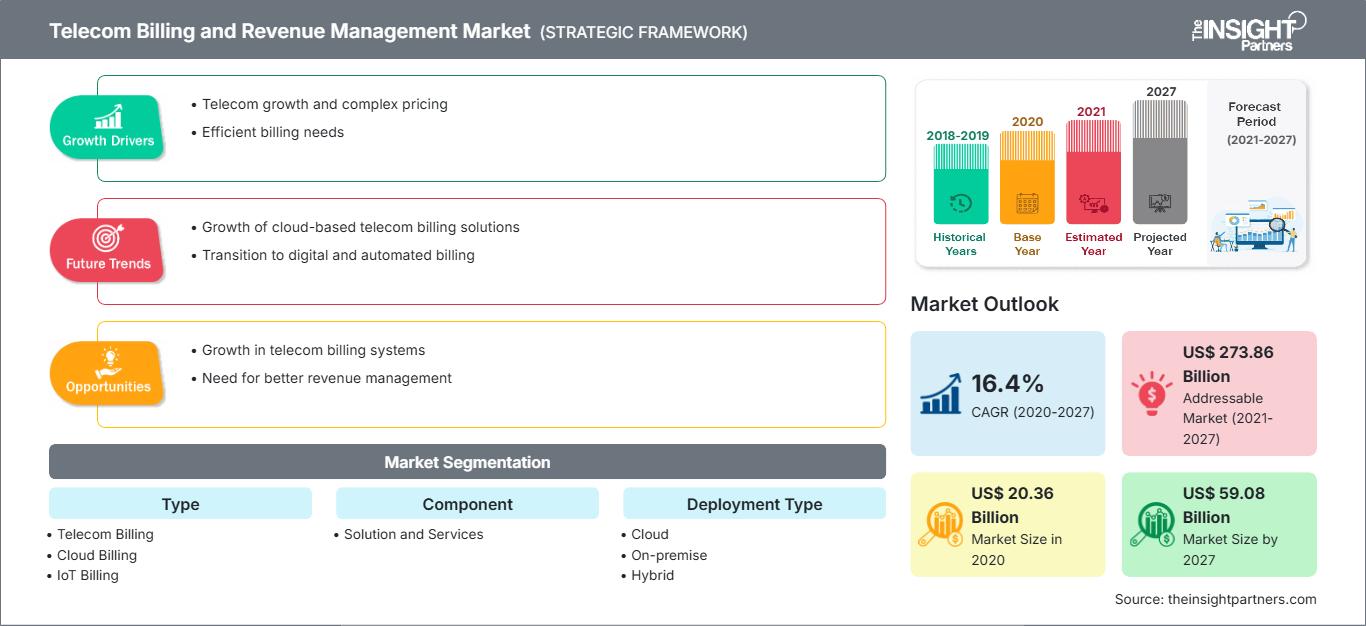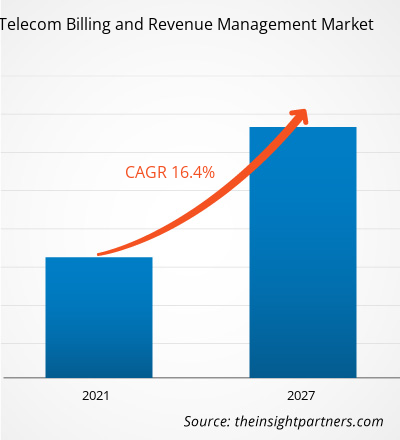Der Markt für Telekommunikationsabrechnung und Umsatzmanagement soll von 20.362,5 Millionen US-Dollar im Jahr 2020 auf 59.075,4 Millionen US-Dollar im Jahr 2027 wachsen; von 2020 bis 2027 wird mit einer durchschnittlichen jährlichen Wachstumsrate (CAGR) von 16,4 % gerechnet.
Der steigende Bedarf an innovativen Lösungen und Diensten für Abrechnung und Umsatzmanagement trägt zum Wachstum des Marktes bei. Der ständige Drang und Bedarf an umfassenden Kommunikationsdiensten und verbesserten, hochwertigen Kundenerlebnissen veranlasst Anbieter von Lösungen und Diensten für Telekommunikationsabrechnung und Umsatzmanagement, solche Lösungen und Dienste weiterzuentwickeln, die kompatibel und gleichwertig sind, um die dynamischen Anforderungen und Ansprüche der Endnutzer mit verbesserter Skalierbarkeit, Flexibilität und Funktionalität vollständig zu erfüllen. Effiziente und flexible Lösungen für Abrechnung und Umsatzmanagement helfen den CSPs, die Daten- und Servicenutzung weiter zu monetarisieren, indem sie den Unternehmen verbesserte Echtzeit-Datenanalysefunktionen und Effizienz bieten, um ihre Einnahmequellen durch die Bereitstellung weiterer maßgeschneiderter Lösungen zu kanalisieren. Es hilft CSPs zudem dabei, die Abrechnungs- und Gebührenprozesse ihrer wachsenden Abonnentenzahl über eine einzige effektive Plattform effizient zu verwalten.
Darüber hinaus unterstützt es Unternehmen dabei und gibt ihnen die Sicherheit, neue maßgeschneiderte Angebote, umsatzgenerierende Dienste und Gebührenrichtlinien in kurzer Zeit und mit verbesserter Effizienz einzuführen und ihre Infrastrukturinvestitionen zu monetarisieren, während sie gleichzeitig das Kunden- und Umsatzmanagement verbessern. CSPs rüsten ihre Altsysteme kontinuierlich auf, indem sie Plattformen hinzufügen, die ihnen dabei helfen, ihren wachsenden Abonnentenstamm zu bedienen, und auf Cloud-basierte Lösungen und Dienste wie SaaS migrieren, wodurch sie ihre Investitionskosten senken und ihre Betriebskosten optimieren können. Darüber hinaus beschleunigen steigende Ausgabentrends und Anforderungen an Lösungen wie BSS/OSS das Wachstum des wettbewerbsintensiven globalen Marktes für Telekommunikationsabrechnung und Umsatzmanagement.
Auswirkungen der COVID-19-Pandemie auf den Markt für Telekommunikationsabrechnung und Umsatzmanagement
Die COVID-19-Krise hatte positive Auswirkungen auf das Wachstum einiger Sektoren wie IT und Telekommunikation. Insbesondere die Nachfrage nach digitalen Diensten ist in den letzten Monaten stark gestiegen. Dennoch wird erwartet, dass der Rückgang von Geschäftsaktivitäten, wie z. B. Partnerschaften zur verstärkten Nutzung von Telekommunikationsabrechnungs- und Umsatzmanagementlösungen in verschiedenen Ländern, das Expansionswachstum der Anbieter von Telekommunikationsabrechnungs- und Umsatzmanagementlösungen negativ beeinflussen wird. Daher wird es gemischte Auswirkungen geben, die das Wachstum in den Jahren 2020 und 2021 leicht zurückgehen lassen werden.
Passen Sie diesen Bericht Ihren Anforderungen an
Sie erhalten kostenlos Anpassungen an jedem Bericht, einschließlich Teilen dieses Berichts oder einer Analyse auf Länderebene, eines Excel-Datenpakets sowie tolle Angebote und Rabatte für Start-ups und Universitäten.
Markt für Telekommunikationsabrechnung und Umsatzmanagement: Strategische Einblicke

-
Holen Sie sich die wichtigsten Markttrends aus diesem Bericht.Dieses KOSTENLOSE Beispiel umfasst Datenanalysen, die von Markttrends bis hin zu Schätzungen und Prognosen reichen.
Telekommunikationsbetreiber und CSPs weltweit sehen sich mit der Komplexität der Systemverwaltung, der Skalierung der Netzwerkinfrastruktur und der Versorgung einer ständig wachsenden Kundenbasis konfrontiert. Eine hohe Betriebseffizienz sowie ein verbessertes Umsatzmanagement und -erhebung sind für Telekommunikationsbetreiber und CSPs eine der obersten Prioritäten und Anforderungen. Effiziente Cloud-basierte Abrechnungslösungen bieten Telekommunikationsbetreibern und CSPs eine einfache, effektive Überwachung der Servicenutzung ihrer Abonnenten entsprechend den Serviceplänen und die entsprechende Abrechnung. Sie helfen CSPs bei der Verwaltung ihrer Zahlungen und Konten und beim Aufbau, der Planung und Optimierung ihrer Netzwerke, während sie Unternehmen gleichzeitig bei der Bewältigung einer großen Anzahl gleichzeitiger Transaktionen und Kundenanfragen unterstützen.
Einer der größten Vorteile, den Cloud-basierte Lösungen und Servicemodelle wie SaaS Telekommunikationsbetreibern und CSPs bieten, sind die niedrigen Anfangsinvestitionen bzw. Kapitalkosten. Es hilft Unternehmen, Infrastrukturinvestitionen und Integrationsbemühungen zu reduzieren, indem es ihnen Möglichkeiten wie das Pay-as-you-go-Modell bietet, mit dem Unternehmen auch neue Lösungen mit geringem Risiko ausprobieren können. Darüber hinaus bieten Servicemodelle wie SaaS Telekommunikationsbetreibern und CSPs die Möglichkeit, neue und bestehende Dienste schnell bereitzustellen und zu unterstützen, wodurch Unternehmen schneller, wirtschaftlicher und flexibler in neue Märkte eintreten können.
Komponentenbasierte Erkenntnisse
Basierend auf den Komponenten ist der Markt für Telekommunikationsabrechnung und Umsatzmanagement in Lösungen und Dienste segmentiert. Die Segmente Lösungen hatten 2019 den größten Marktanteil.
Akteure auf dem Markt für Telekommunikationsabrechnung und Umsatzmanagement konzentrieren sich hauptsächlich auf die Entwicklung fortschrittlicher und effizienter Produkte.
- Im Jahr 2020 hat sich TDC, ein dänischer Betreiber, für Comarch SA entschieden, um seine BSS-Lösungen anzubieten. Das Unternehmen bot TDC sein Kundenauftragsmanagement, sein konvergentes Abrechnungssystem und sein Framework zur Anwendungsintegration an.
- Im Jahr 2020 arbeitete Telecom Fiji Limited, Anbieter von Telefoniediensten, mit Oracle Communications zusammen, um die Kundenbindung zu verbessern und die Bereitstellung von Produkten und Dienstleistungen zu beschleunigen. Das Unternehmen wird das Abrechnungs- und Umsatzmanagement von Oracle als Teil der Oracle Digital Experience for Communications-Suite einsetzen, um ein digitales Kundenerlebnis zu ermöglichen.
Der Markt für Telekommunikationsabrechnungs- und Umsatzmanagement wurde wie folgt segmentiert:
Markt für Telekommunikationsabrechnungs- und Umsatzmanagement – nach Komponenten
- Lösung
- Abrechnungsmanagement
- Kontoverwaltung
- Sonstige
- Dienste
- Professionelle Dienste
- Managed Services
Markt für Telekommunikationsabrechnungs- und Umsatzmanagement – nach Typ
- Telekommunikationsabrechnung
- Cloud-Abrechnung
- IoT-Abrechnung
Markt für Telekommunikationsabrechnung und Umsatzmanagement – nach Bereitstellungstyp
- Vor Ort
- Cloud-basiert
- Hybrid
Markt für Telekommunikationsabrechnung und Umsatzmanagement – nach Geografie
-
Nordamerika
- USA
- Kanada
- Mexiko
-
Europa
- Frankreich(APAC)
- Japan
- China
- Australien
- Indien
- Rest von APAC
-
Naher Osten und Afrika (MEA)
- VAE
- Dubai
- Saudi-Arabien
- Katar
- Süd Afrika
- Äthiopien
- Ruanda
- Kenia
- Elfenbeinküste
- Ghana
- Nigeria
- Ägypten
- Marokko
- Tunesien
- Türkei
- Rest von MEA
-
Südamerika (SAM)
- Brasilien
- Argentinien
- Chile
- Peru
- Kolumbien
- Rest von SAM
Regionale Einblicke in den Markt für Telekommunikationsabrechnung und Umsatzmanagement
Die Analysten von The Insight Partners haben die regionalen Trends und Faktoren, die den Markt für Telekommunikationsabrechnung und Umsatzmanagement im Prognosezeitraum beeinflussen, ausführlich erläutert. In diesem Abschnitt werden auch die Marktsegmente und die geografische Lage in Nordamerika, Europa, im asiatisch-pazifischen Raum, im Nahen Osten und Afrika sowie in Süd- und Mittelamerika erörtert.
Umfang des Marktberichts zu Telekommunikationsabrechnung und Umsatzmanagement
By Komponente- Lösung und Dienste
- Cloud
- Vor Ort
- Hybrid
- Großbritannien
- Deutschland
- Frankreich
- Russland
- Italien
- Restliches Europa
- China
- Indien
- Japan
- Australien
- Restlicher Asien-Pazifik
- Brasilien
- Argentinien
- Restliches Süd- und Mittelamerika
- Südafrika
- Saudi-Arabien
- Vereinigte Arabische Emirate
- Restlicher Naher Osten und Afrika
Berichtsattribut Einzelheiten Marktgröße in 2020 US$ 20.36 Billion Marktgröße nach 2027 US$ 59.08 Billion Globale CAGR (2020 - 2027) 16.4% Historische Daten 2018-2019 Prognosezeitraum 2021-2027 Abgedeckte Segmente By Typ - Telekommunikationsabrechnung
- Cloud-Abrechnung
- IoT-Abrechnung
Abgedeckte Regionen und Länder Nordamerika - USA
- Kanada
- Mexiko
Marktführer und wichtige Unternehmensprofile - Accenture PLC
- Alcatel-Lucent S.A.
- Amdocs, Inc.
- Cerillion PLC
- CSG Systems International, Inc.
- Ericsson
- goTransverse International, Inc.
- Hewlett-Packard Development Company L.P.
- Huawei Technologies Co., Ltd.
Dichte der Marktteilnehmer im Bereich Telekommunikationsabrechnung und Umsatzmanagement: Auswirkungen auf die Geschäftsdynamik verstehen
Der Markt für Telekommunikationsabrechnung und Umsatzmanagement wächst rasant. Dies wird durch die steigende Endkundennachfrage aufgrund veränderter Verbraucherpräferenzen, technologischer Fortschritte und eines stärkeren Bewusstseins für die Produktvorteile vorangetrieben. Mit der steigenden Nachfrage erweitern Unternehmen ihr Angebot, entwickeln Innovationen, um den Bedürfnissen der Verbraucher gerecht zu werden, und nutzen neue Trends, was das Marktwachstum weiter ankurbelt.

- Holen Sie sich die Markt für Telekommunikationsabrechnung und Umsatzmanagement Übersicht der wichtigsten Akteure
Markt für Telekommunikationsabrechnung und Umsatzmanagement – Unternehmensprofile
- Accenture PLCCorporation
- Oracle Corporation
- Redknee, Inc.
- SAP SECIS
- ESKADENIA
- Netcracker
- Frankreich(APAC)
- Historische Analyse (2 Jahre), Basisjahr, Prognose (7 Jahre) mit CAGR
- PEST- und SWOT-Analyse
- Marktgröße Wert/Volumen – Global, Regional, Land
- Branchen- und Wettbewerbslandschaft
- Excel-Datensatz
Aktuelle Berichte
Verwandte Berichte
Erfahrungsberichte
Grund zum Kauf
- Fundierte Entscheidungsfindung
- Marktdynamik verstehen
- Wettbewerbsanalyse
- Kundeneinblicke
- Marktprognosen
- Risikominimierung
- Strategische Planung
- Investitionsbegründung
- Identifizierung neuer Märkte
- Verbesserung von Marketingstrategien
- Steigerung der Betriebseffizienz
- Anpassung an regulatorische Trends






















 Kostenlose Probe anfordern für - Markt für Telekommunikationsabrechnung und Umsatzmanagement
Kostenlose Probe anfordern für - Markt für Telekommunikationsabrechnung und Umsatzmanagement